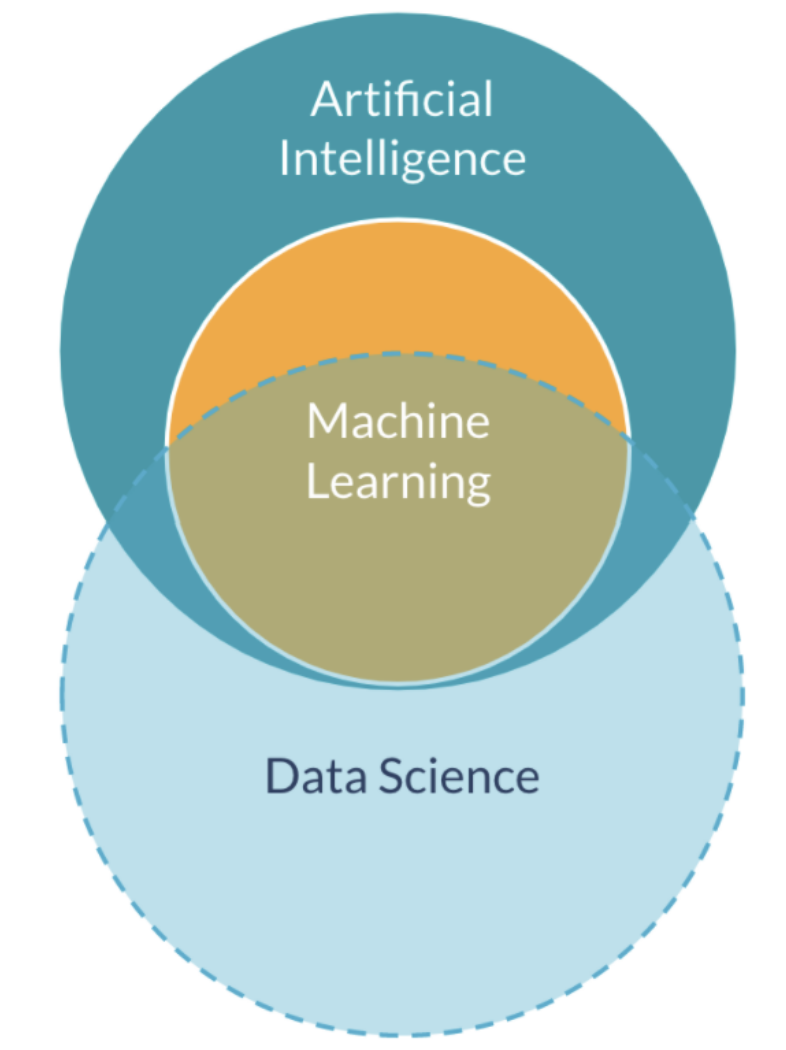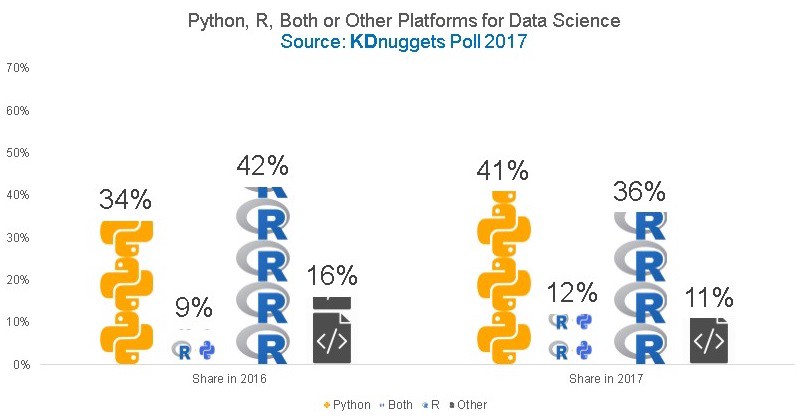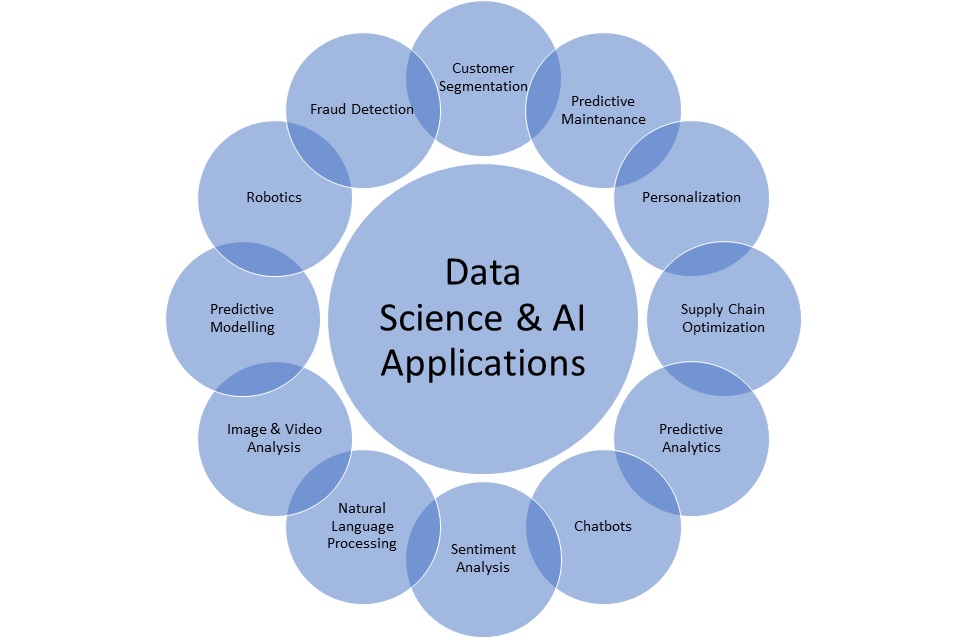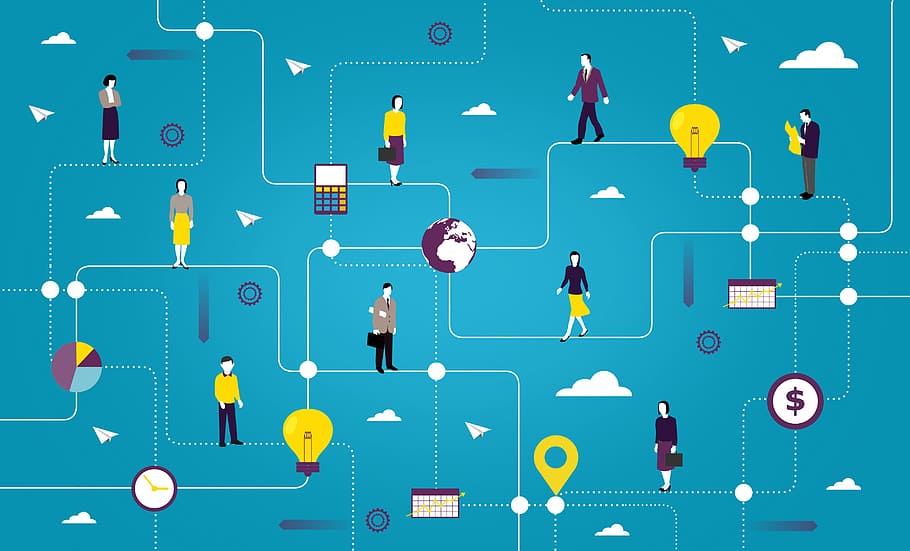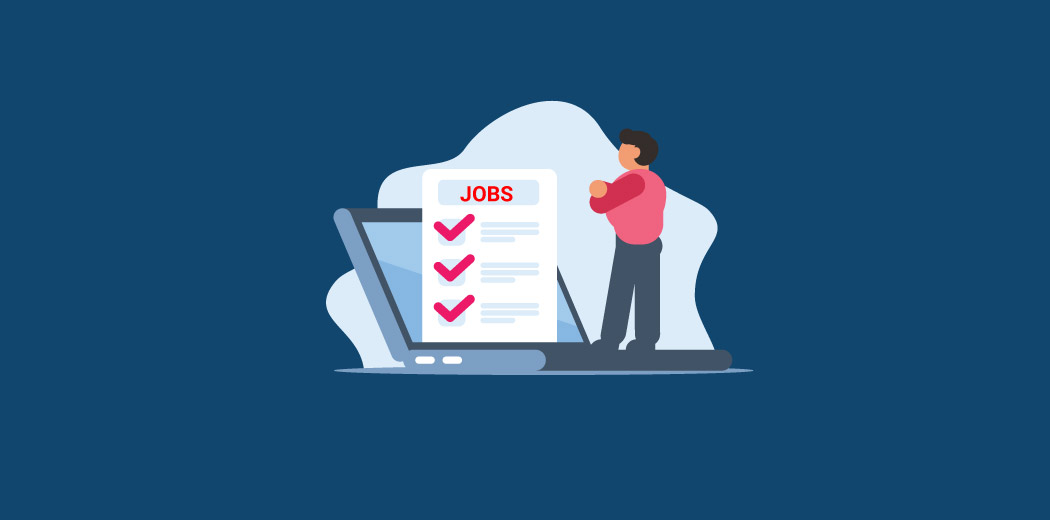Introduction
Data Science and Artificial Intelligence (AI) are two of the most rapidly growing and exciting technological fields today. Both disciplines are revolutionizing how we process, analyze, and make sense of data to solve complex problems and make informed decisions.
In this blog, we will delve into the definitions of Data Science and AI, explore the differences between the two, and examine the top languages involved in these fields. We will also look at the top 12 applications of Data Science and AI in various industries and the job trajectory for a Data Scientist in India. Finally, we will discuss the top 10 jobs in AI for Data Scientists and how Artificial Intelligence can help professionals secure good jobs and higher salaries.
What is Data Science?
Data Science is a field that combines the power of scientific methods, processes, algorithms, and systems to extract valuable insights and knowledge from data. This data can be structured and unstructured and may come from various sources such as databases, social media, sensors, etc. It involves using statistical and mathematical techniques to analyze and interpret data and programming and visualization skills to present the findings meaningfully.
Data Scientists use various tools and techniques to extract value from data, such as machine learning, natural language processing, and data visualization. They work with many data sources, including social media, sensors, transactions, and more, to identify trends, patterns, and relationships to help businesses, organizations, and individuals make better decisions.
What is Artificial Intelligence?
Artificial Intelligence, or AI, is a branch of computer science that aims to create intelligent machines that can think and act like humans. AI systems can be trained to perform various tasks, from simple, repetitive tasks to more complex and cognitive tasks that involve understanding and processing large amounts of data. At its core, AI is designed to mimic the cognitive functions of the human brain, allowing it to adapt and learn from experience to perform tasks more efficiently and accurately over time.
There are different types of AI, including narrow or weak AI, which is designed to perform a specific task, and general or strong AI, which has the ability to perform any intellectual task that a human can. Some examples of AI include self-driving cars, virtual assistants like Siri or Alexa, and recommendation systems like those used by Netflix or Amazon.
Difference Between Data Science and Artificial Intelligence
Source: Jenal Desai.com
While Data Science and AI are often used interchangeably, they are actually two distinct fields that overlap in some areas but also have their unique focus and goals. Data Science primarily analyzes and interprets data to extract insights and inform decision-making. It involves using statistical and mathematical techniques to analyze and interpret data and programming and visualization skills to present the findings meaningfully.
Conversely, AI is focused on creating intelligent machines that can think and act like humans. It involves the development of algorithms and systems that can process and analyze data, learn from it, and make decisions based on that learning. To further clarify the difference between Data Science and AI, it’s helpful to consider some specific examples. For instance, a Data Scientist might use machine learning algorithms to analyze customer data and predict which products a particular customer is likely to purchase. This would involve analyzing and interpreting data to extract insights and inform decision-making.
On the other hand, an AI engineer might use machine learning algorithms to build a self-driving car that can navigate roads and traffic on its own. This would involve creating an intelligent system that can process and analyze data from sensors and cameras, learn from it, and make decisions based on that learning.
Top 5 Languages Involved in Data Science and Artificial Intelligence
1. Python:
Python is a popular programming language in the field of Data Science and AI due to its simplicity, versatility, and large community of users. It has a vast range of libraries and frameworks, such as NumPy, Pandas, Matplotlib, and sci-kit-learn, that make it easy to work with data and build machine learning models.
2. R:
R is another popular programming language in Data Science, mainly for statistical analysis and data visualization. It has an extensive collection of packages and libraries, such as ggplot2 and dplyr, that make it easy to manipulate, analyze, and visualize data.
3. Java:
Java is a widely used programming language that is popular in the field of AI due to its scalability and performance. It is often used to build machine learning models and large-scale AI applications.
4. C++:
C++ is a high-performance programming language that is often used in the field of AI, particularly for building complex and resource-intensive applications. It is known for its speed, efficiency, and ability to handle large amounts of data.
5. Lisp:
Lisp is a programming language that has been around for over 60 years and is known for its simplicity and flexibility. It is often used in AI for building expert systems and natural language processing applications.
Top 12 Applications of Data Science and Artificial Intelligence
- Predictive Modelling and Analytics: Data science and AI can analyze large amounts of data and predict future events, such as consumer behaviour or market trends.
- Image and Voice Recognition: AI algorithms can be trained to recognize images, videos, and speech, which is used in applications such as facial recognition and voice-controlled virtual assistants.
- Natural Language Processing: Data science and AI can be used to analyze, understand and generate human language, which is used in applications such as machine translation, sentiment analysis, and chatbots.
- Robotics and Automation: Data science and AI can be used to control and program robots, which can be used in industries such as manufacturing, logistics, and healthcare.
- Self-driving Cars: Data science and AI are used to develop the algorithms that enable cars to drive themselves, which has the potential to reduce accidents caused by human error significantly.
- Fraud Detection: Data science and AI can be used to analyze patterns of behaviour and detect suspicious activity, which is used in applications such as credit card fraud detection and cybersecurity.
- Personalization: Data science and AI can create personalized user experiences, such as personalized recommendations on e-commerce websites or streaming platforms.
- Healthcare: Data science and AI can be used in many areas of healthcare, such as drug discovery, medical imaging, and precision medicine, which uses genetic information to tailor treatment to individual patients.
- Climate Modelling: Data science and AI can be used to analyze large amounts of data on the Earth’s climate, which can help scientists understand and predict the effects of climate change.
- Agriculture: Data science and AI can be used to analyze data from sensors and drones, which can help farmers optimize their crop yields, reduce waste and improve overall efficiency.
- Energy: Data science and AI can be used to predict and optimize energy usage in buildings and power grids.
- Marketing: Data science and AI can be used to analyze consumer data and behaviour to create more effective marketing strategies.
12 Industry Problem Statements and Solutions Facilitated by Using Data Science and Artificial Intelligence
1. Social Media:
Understanding user behaviour and predicting viral content is crucial to the success of social media platforms. However, detecting fake news and propaganda is also a significant challenge. To address these challenges, data science and AI can analyze user data and identify patterns, which can then inform decision-making around content curation, personalized recommendations, and content moderation. Machine learning algorithms can classify the authenticity of the news and segregate fake news from real.
2. Healthcare:
Improving patient outcomes, reducing costs, and predicting disease outbreaks are all significant challenges in the healthcare industry. Data science and AI can be used to analyze patient data and identify patterns that inform treatment decisions. For example, by analyzing a patient’s medical history and other relevant data, a machine learning model could predict their likelihood of developing a specific condition and help doctors make more informed treatment decisions. Additionally, AI-powered tools can monitor patients remotely, which could help reduce costs and improve patient outcomes.
3. Finance:
Predicting market trends, detecting fraudulent activity, and automated trading are all significant challenges in the finance industry. Data science and AI can be used to analyze financial data and identify patterns that can be used to inform investment decisions, detect fraudulent activity, and automate trading.
4. E-commerce:
In the e-commerce industry, predicting customer behaviour, optimizing product recommendations, and detecting fraudulent activity are all major challenges. Data science and AI can be used to analyze customer data and predict product purchases, which can inform product recommendations and marketing strategies. Additionally, machine learning algorithms can identify fraudulent activity patterns and detect fraudulent transactions in real-time.
5. Manufacturing:
One of the challenges in the manufacturing industry is predicting equipment failures, optimizing production processes, and improving supply chain efficiency. Data science and AI can be used to analyze data from manufacturing equipment and identify patterns that can inform decisions about when to perform maintenance, optimize production processes, and improve supply chain efficiency.
6. Transportation:
Optimizing routes and schedules, predicting traffic patterns, and improving safety are major challenges in the transportation industry. Data science and AI can analyze GPS and traffic sensor data to optimize routes and schedules, predict traffic patterns, and identify potential accidents or malfunctions. This can help transportation companies to plan and optimize their routes, improve the efficiency of their operations and ensure the safety of their passengers and drivers.
7. Energy:
In the energy industry, predicting demand, optimizing production and distribution, and improving efficiency are all significant challenges. Data science and AI can be used to analyze data on energy consumption patterns, predict demand, and optimize production and distribution. Additionally, AI-powered systems can be used to manage renewable energy sources, such as wind and solar, to improve the overall efficiency of the energy system.
8. Agriculture:
In agriculture, predicting crop yields, optimizing irrigation and fertilization, and predicting weather patterns are all significant challenges. Data science and AI can be used to analyze data from satellite imagery, soil sensors, and weather data to optimize crop management and predict yields. This can help farmers make informed decisions about when to plant, when to fertilize, and how to irrigate their crops, leading to higher yields and lower costs.
9. Education:
Personalizing learning, predicting student performance, and detecting plagiarism are major challenges in the education industry. Data science and AI can be used to analyze student data and create personalized learning plans, predict performance, and detect plagiarism. This can help educators create learning experiences tailored to each student’s needs and abilities, leading to better outcomes and higher student satisfaction.
10. Advertising:
In advertising, targeting advertising, predicting ad effectiveness, and detecting fraudulent activity are all significant challenges. Data science and AI can be used to analyze user data and optimize ad targeting, predict ad effectiveness, and detect fraudulent activity. This can help advertisers to create more effective campaigns that reach the right audience and achieve better results.
11. Real Estate:
In the real estate industry, predicting property values, identifying market trends, and detecting fraudulent activity are all major challenges. Data science and AI can analyze property data and predict values, identify market trends, and detect fraudulent activity. This can help real estate professionals make more informed decisions about buying and selling properties, leading to better outcomes for buyers and sellers.
12. Environmental Monitoring:
In the environmental monitoring industry, predicting weather patterns, identifying pollution sources, and optimizing resource usage are all major challenges. Data science and AI can analyze weather sensors and satellite imagery data to predict weather patterns, identify pollution sources, and optimize resource usage. This can help organizations plan for weather events, locate the sources of pollution, and minimize resource consumption, leading to a more sustainable environment and improving the overall quality of life.
Job Trajectory for a Data Scientist in India
- Intern: As an intern, a Data Scientist in India may work on small projects or assist senior team members with data analysis tasks.
- Data Scientist: A Data Scientist in India may be responsible for designing and implementing data-driven solutions to business problems, such as building predictive models or analyzing customer data.
- Data Science Team Lead: A Data Science Team Lead in India may be responsible for managing and leading a team of Data Scientists and driving the development and execution of data-driven projects.
- Manager of Data Science: A Manager of Data Science in India may oversee the entire data science function within a company, including setting strategy, managing budgets, and driving the integration of data science into business operations.
- Chief Data Scientist: A Chief Data Scientist in India may lead the data science function across an entire organization, including setting the overall vision and strategy for data-driven decision-making. They may also be responsible for building and maintaining relationships with key stakeholders and ensuring that the data science function is aligned with the overall goals and objectives of the organization.
Top 10 Jobs in Data Science and Artificial Intelligence
- Data Scientist: Responsible for analyzing and interpreting complex data sets to uncover insights and inform business decisions.
- Machine Learning Engineer: Design, develop and implement machine learning models to solve real-world problems.
- Business Intelligence Analyst: Use data and statistical methods to develop insights and support decision-making in a business environment.
- Data Engineer: Build and maintain the infrastructure and systems for data storage and processing to support data scientists and analysts.
- Research Scientist: Develop and use statistical and machine learning models to conduct research and solve complex problems in various fields.
- Big Data Engineer: Design, build, and maintain large-scale data processing and storage infrastructure.
- Data Analyst: Collect, clean and analyze data to inform business decisions and identify trends and patterns.
- Statistician: Use statistical methods and analysis to help solve problems in fields such as healthcare, finance, and sports.
- Data Architect: Design and oversee the data infrastructure and systems development to ensure they meet the organisation’s needs.
- Business Analyst: Utilize data analysis and modelling to help organizations identify and solve problems and make data-driven decisions.
Conclusion
Data Science and Artificial Intelligence are rapidly growing and exciting fields transforming how we process, analyze, and make sense of data. While they have some overlap in terms of tools and techniques, they also have their unique focus and goals. Data Science primarily analyzes and interprets data to extract insights and inform decision-making. In contrast, AI is focused on creating intelligent machines that can think and act like humans.
Key Features That Make Analytics Vidhya #1 Choice:
- Best Curriculum: Analytics Vidhya with 17 + modules that covers A to Z of machine learning.
- Detailed Program: For students and professionals looking to enter or advance in the field of Data Science and AI, a comprehensive program like the one offered by Analytics Vidhya can be a valuable resource.
- Placement Assistance: The program’s job assistance services and career support can help secure good jobs and higher salaries in the field of Data Science and AI. Thanks to the 100+ companies that participate in AV’s hiring drives.
- Regarding enrolling for data science courses online, Analytics Vidyha is known for its affordable pricing plans.





